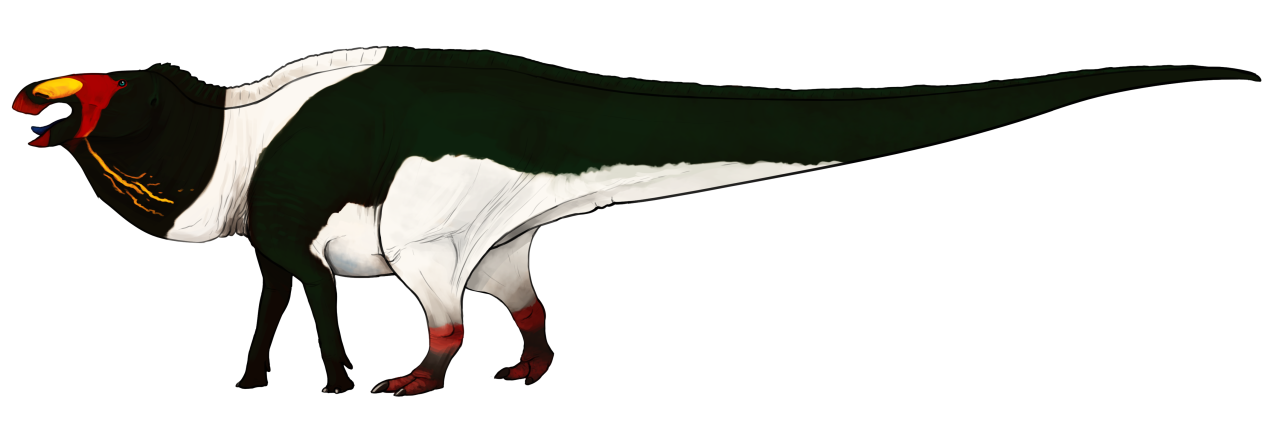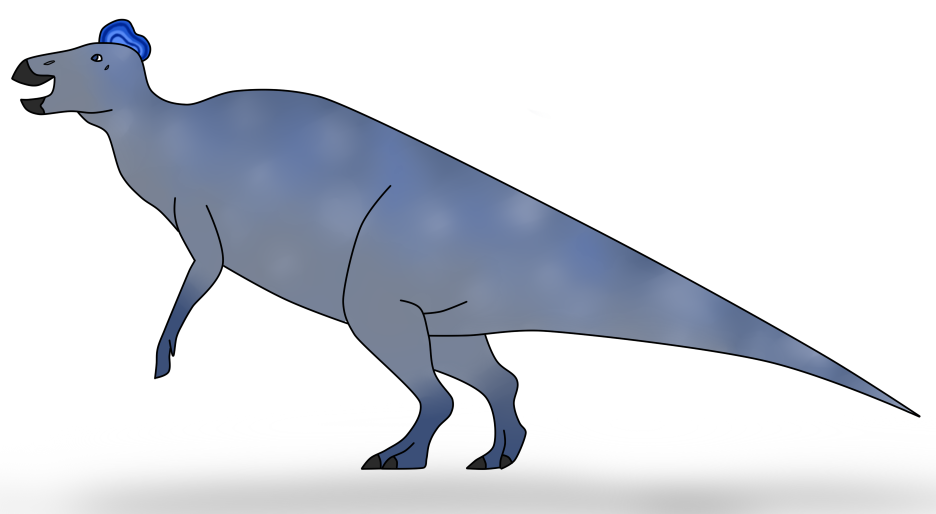Edmontosaurus regalis, E. annectens

E. regalis, by José Carlos Cortés on @ryuukibart
Name: Edmontosaurus regalis, E. annectens
Name Meaning: Edmonton Reptile
First Described: 1917
Described By: Lambe
Classification: Dinosauria, Ornithischia, Genasauria, Neornithischia, Cerapoda, Ornithopoda, Iguanodontia, Dryomorpha, Ankylopollexia, Styracosterna, Hadrosauriformes, Hadrosauroidea, Hadrosauridae, Saurolophinae, “Anatosauria”, Edmontosaurini
First, a caveat: I believe that dinosaurs are over-split into separate genera too much as it is. As such, given their very short time away from one another evolutionarily, and extreme similarity, I have decided to lump Edmontosaurus regalis and “Anatosaurus” annectens together into Edmontosaurus. This goes against decisions made by others, but it is the general modern consensus on these genera. Now that we’ve gotten that awkwardness out of the way, Edmontosaurus is arguably one of the best known general of Hadrosaurs, known from many specimens across both species that have been thoroughly studied. It was a long lived genus, with E. regalis living about 73 to 70 million years ago in the Horseshoe Canyon Formation in Alberta, living in the Campanian age of the Late Cretaceous; and E. annectens living in multiple formations of the Maastrichtian age of the Late Cretaceous: the Frenchman Formation in Saskatchewan, Canada, the Hell Creek Formation in Montana, and the Lance Formation in South Dakota and Wyoming, dating to about 67 to 66 million years ago. Though the two species are separated by time, they are closely related phylogenetically, representing sister species in a monophyletic clade.

E. regalis by Nobu Tamura, taken from Wikipedia, CC BY 2.5
The two species of this genus do differ in a number of ways: E. annectens have a lower, longer, and less robust skull - much like the bill of a duck, from which older genus names for the species that have since been sunk (”Anatosaurus” and “Anatotitan”) came from. In addition, E. regalis is known to have a comb structure on its head made of soft tissue, preserved in some of the very well preserved almost mummy like specimens of the species; it is uncertain whether or not this crest was sexually dimorphic (as there is not enough of a sample size to determine such a distribution), or if it was present in E. annectens. Beyond that, however, the two are essentially identical in terms of skeletal morphology. In fact, the general size of these animals varied extensively, and they reached huge maximum sizes. A fully grown adult typically reached 9 meters long, but could grow up to 12 meters or even 13 meters, and weighing 4 metric tonnes. E. annectens is typically smaller, though large specimens of the animal may challenge that assumption. Large individuals of up to 15 meters long were possible, but rare, as it required reaching a very advanced age.

E. annectens, by Maya McCallum on @hauntedmech
The paleontological history of this genus is a wee bit of a mess, due to the extensive number of other genera named off of the skeletal elements involved. Anatosaurus itself was named solely to try and make sense of the mess of crestless hadrosaur taxonomy, but it didn’t actually help much in this pursuit. In addition, E. annectens was originally named “Claosaurus annectens” by Marsh in the 1890s, and many specimens of Edmontosaurus were assigned to Claosaurus and Trachodon, creating a large taxonomic mess. A revision in 1902 reassigned almost all of them to Trachodon, until in 1910 new material caused a revision and a reassigning of greater diversity to Hadrosaurid specimens. Claosaurus was sunk in to Thespesius, which were considered to be the same, though the species name was later assigned to Anatosaurus, which was then lumped into Edmontosaurus. These specimens included the “Trachodon Mummy,” a very well preserved Edmontosaurus specimen. Many other species of Anatosaurus and Anatotitan were named, as well as Edmontosaurus, but they have all since been sunk into Edmontosaurus as various ontogenic stages of the genus.

E. annectens, by Jack Wood on @thewoodparable
From this mess, however, a better understanding of E. regalis growth sequences has come about. Many of the features of E. regalis skulls that were used to describe new genera were found to directly correlate with skull size, indicating that the shape of the skull changed dramatically as it grew. Ontogenic stages for E. annectens have also been found, with the skull becoming longer and flatter as the animals grew. Juvenile and nestling size specimens of the genus are also known, however, that paper has not come out yet, so… I’ll add more about this later. Endocasts have also been used to study the brains of both species, which was not particularly large - though this may have been made up for by a higher neuronal density, which has been found in birds. The brain had an elongate structure, much like that of other Ornithischians.

E. annectens and E. regalis, by @spirellity
Edmontosaurus is famous for it extreme battery of teeth, with the teeth primarily being in the upper cheeks and lower jaw, and not in the front of the bouth (the bill portion of the skull). The teeth grew in columns with a maximum of six in each, and the number of columns dependent on the size of the animal. There around 51 to 53 columns in the upper jaw and 46 to 49 in the lower jaw for E. regalis, and 52 for the upper jaw and 44 for the lower in E. annectens. Its shoulder blades were long and flat, held parallel to the vertebrae. It had shorter and thinner forelimbs than its hindlimbs, where its hind limbs were very robust and probably significantly stronger. Many skin portions of this genus have also been preserved, so that its integument is known for most of its body. It had non overlapping scales which were quite small and polygonal. Food has also been found in the gut of this animal, however these fossils were described very early on in the understanding of Edmontosaurus and have not been able to be thoroughly studied. However, isotopic studies of Edmontosaurus has indicated that it probably had a diet mostly composed of Gymnosperms.

E. annectens, by Nobu Tamura, taken from Wikipedia, CC BY 2.5
Edmontosaurus, like other hadrosaurids, was a facultative biped, allowing it to adopt both quadrupedal and bipedal stances. The fastest it could go was galloping and running bipedally, though it was never at extremely high speeds. It was not well suited to swimming like other dinosaurs, as its forelimbs were ineffective for propulsion, and its tail had ossified tendons that also would make this activity difficult. Skeletons of E. annectens show signs of predation from Tyrannosaurus, with whom it was contemporaneous; including bites and damage on the top of the tail, which partially healed (but prevented from fully healing before the animal died). There was also signs of bone infection. This indicates that it outmaneuvered its attacker, but still succumbed to the injuries. It is possible that the tail was also used as a weapon agains the Tyrannosaur. Evidence of attack from smaller theropods has also been found on E. annectens.

By Jem McCormick on @excessively-english-little-b
Edmontosaurus is known from extensive bone beds with many individuals, covering large areas and with thousands of individuals present. It probably used its soft tissue display structures to both allow for species recognition and to communicate between members of the species. It is also possible that Edmontosaurus was a migratory species, with studies of bone microstructure indicating that Edmontosaurus went to Northern locations as well as southern ones and experienced overwintering ecologies. However, given the description of Ugrunaaluk, whether or not this was an actual behavior or rather just different species remains to be seen, and more studies on this potential activity are necessary.

E. annectens, by Maya McCallum on @hauntedmech
E. regalis in Alberta lived alongside many other dinosaurs such as Hypacrosaurus, Saurolophus, Parksosaurus, Montanoceratops, Anchiceratops, Arrhinoceratops, Pachyrhinosaurus, Stegoceras, Euoplocephalus, Edmontonia, Ornithomimus, Struthiomimus, Albertosaurus, and Daspletosaurus, as well as other indeterminant dinosaurs. IN addition it lived in a cypress swamp and peat bogs on the coast of the Ocean, preferring it to the flood plains that many of its contemporaries lived on. E. annectens, on the other hand, lived alongside many other dinosaurs, including Triceratops, which it possibly associated with and lived alongside with in extreme amounts. It also lived alongside thescelosaurus, Pachycephalosaurus, Ankylosaurus, Ornithomimus, Troodon, and Tyrannosaurus. In Hell Creek it lived in a subtropical forested environment, with man angiosperms as well as conifers. IN the Lance FOrmation it lived in a more bayou like formation, closer to a large delta with tropical conifers and palm trees abundant, in a very humid and tropical climate, which preserved the Edmontosaurus mummies known.
Sources:
https://en.wikipedia.org/wiki/Edmontosaurus_annectens
https://en.wikipedia.org/wiki/Edmontosaurus_regalis
https://en.wikipedia.org/wiki/Edmontosaurus
Shout out goes to @moonofthestrawberries!



















